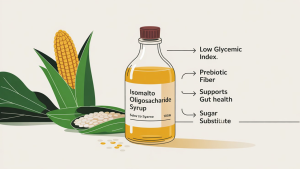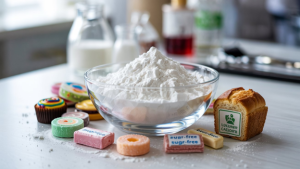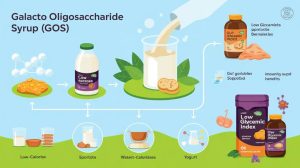High Fructose Powder: A Concentrated Sweetening Agent for Dry Formulations and Functional Applications

High fructose powder is a crystalline sweetener engineered for industrial use in dry and low-moisture formulations. Derived from non-GMO corn starch through enzymatic conversion and precision crystallization, this ingredient offers high sweetness intensity, excellent solubility, and low hygroscopicity—making it a preferred choice in powdered drink mixes, functional foods, and sugar-reduction systems.
With increasing demand for sugar alternatives that maintain product performance without compromising flavor or shelf stability, High fructose powder addresses formulation challenges in dry and low-moisture systems, making it particularly suitable for manufacturers in the functional food, beverage, and nutraceutical sectors.
Ingredient Profile and Manufacturing Process
High fructose powder is produced via enzymatic isomerization of glucose derived from corn starch, followed by multi-step purification and spray-drying. The result is a white, free-flowing powder containing a high proportion of fructose (typically 90% or higher), offering approximately 1.2–1.8 times the sweetness of sucrose.
Compared to high fructose corn syrup (HFCS), which is used primarily in liquid formulations, the powdered form ensures longer shelf life, better compatibility with dry processing environments, and easier transport and handling. It is stable across a wide range of pH and processing temperatures, and highly soluble in cold and hot water systems, allowing smooth integration into powdered premixes and dry-matrix formulations.

Optimizing Sweetness and Stability in Industry-Ready Formulations
1. Dry Beverages and Instant Mixes
The solubility and rapid dispersibility of high fructose powder make it ideal for powdered soft drinks, rehydration salts, and flavored instant beverages. It enhances mouthfeel and delivers sweetness with minimal bulk addition.
According to a study published in the Journal of Food Science and Technology, fructose demonstrates higher water solubility compared to glucose and sucrose, allowing for rapid dispersion in dry beverage formulations (Patel & Rao, 2013).
2. Protein Bars and Functional Snacks
Its low water activity supports microbial stability in high-protein or low-moisture environments. Additionally, the sweetness profile improves palatability in nutrient-dense products.
Research in LWT – Food Science and Technology confirms that fructose’s hygroscopic properties and low water activity make it advantageous in formulations where shelf stability and texture maintenance are critical, such as in protein-enriched bars (Li et al., 2016).
3. Diabetic-Adapted and Low-GI Products
Fructose has a lower glycemic index (GI ~15–25) than glucose or sucrose, making the powder suitable for use in blood-sugar-sensitive product lines, provided intake is controlled. It is often incorporated into diabetic-formulated snacks, powders, and supplements.
According to the American Diabetes Association and findings in Nutrients Journal, fructose has a lower GI due to its liver-first metabolism, which results in a smaller immediate impact on blood glucose compared to other sugars (Livesey & Taylor, 2008; ADA, 2020).
4. Bakery Premixes and Industrial Baking
In dry bakery mixes, high fructose powder serves as a moisture-stable sweetener that enhances browning and flavor release during baking. It performs well under high-temperature processes while maintaining its sweetening capacity.
A study in Food Chemistry demonstrates that fructose enhances Maillard browning and flavor compound release more efficiently than sucrose under thermal processing, making it suitable for baked goods (Zhu et al., 2014).
Technical Specifications (Typical Range)
| Parameter | Specification |
| Fructose Content | ≥90% (dry basis) |
| Moisture Content | ≤2.0% |
| Ash | ≤0.1% |
| Solubility | 100% in water (25°C) |
| Particle Size | 80–200 mesh |
| Heavy Metals | Pb ≤ 0.5 ppm, As ≤ 0.3 ppm |
| Microbial Limits | TPC ≤ 1000 cfu/g, Yeast/Mold ≤ 50 |
| Shelf Life | 24 months (under dry, sealed conditions) |
Packaging formats include 25 kg fiber drums or foil-lined kraft paper bags with double-layer moisture barriers to ensure storage stability during transit and warehouse operations.
Storage & Handling Guidelines
To maintain powder integrity:
- Store in sealed, airtight packaging away from moisture and volatile compounds.
- Avoid high humidity environments to prevent clumping.
- Label containers with batch numbers and opening dates to track freshness.
- Shelf life is typically 24 months under recommended conditions (cool, dry, and <25°C).
Health and Regulatory Considerations
While high fructose powder offers functional benefits in reduced-sugar and glycemic-friendly product development, usage levels must be evaluated in light of current dietary recommendations and regional food regulations.
According to the FDA and EFSA, fructose is Generally Recognized As Safe (GRAS) for food use. However, excessive intake may contribute to metabolic imbalances, particularly in individuals with fructose malabsorption. Formulators should monitor usage levels in line with nutritional labeling standards and product positioning.
We supply food-grade high fructose powder that meets rigorous purity standards. Each batch is supported by:
- Certificate of Analysis (COA)
- Microbiological and heavy metal testing
- Allergen-free, non-GMO compliance
- Kosher and Halal certification (upon request)
Our production facilities are ISO and GMP certified, and our technical support team assists with formulation compatibility, regulatory compliance, and shipping logistics. To request a sample or bulk quotation, [contact us here] or visit our product page.
Frequently Asked Questions
Q: Is high fructose powder interchangeable with high fructose corn syrup?
A: No. Though both are fructose-rich, HFCS is a liquid, while the powder is optimized for dry applications with different handling and stability properties.
Q: Can high fructose powder be used in keto or low-carb products?
A: It is still a carbohydrate, so suitability depends on specific dietary goals. It’s not keto-friendly but may work in controlled low-GI applications.
Q: Is the powder gluten-free?
A: Yes. It is naturally gluten-free and suitable for gluten-sensitive applications, provided production avoids cross-contamination.
Q: Does it affect baking time or texture?
A: Yes. It enhances browning and may reduce moisture retention. Formulators may need to adjust liquids and baking temperature accordingly.
References List
- Patel, D., & Rao, T. (2013). Solubility properties of sugars and their impact on dry beverage mixes. Journal of Food Science and Technology, 50(5), 931–937.
- Li, Q., Sun, W., & Wang, M. (2016). Water activity control in protein bars using polyols and sugar alternatives. LWT – Food Science and Technology, 73, 394–400.
- Livesey, G., & Taylor, R. (2008). Fructose and metabolic health: Evidence from controlled feeding trials. Nutrients, 1(1), 1–20.
- American Diabetes Association. (2020). Glycemic index and diabetes. https://www.diabetes.org/
Related recommendations
-
Isomalto Oligosaccharide Syrup: Versatile Prebiotic
818Support Digestion And Wellness With Sgnutri's Imo Syrup – Ideal For Health Foods And Functional Beverages.
View details -
Natural Isomalt Review — A Sweetener That Actually Gets the Job Done
554Learn Whether Isomalt Is Natural, And Discover Its Color, Texture, And Functional Use As A Low-Calorie Sugar Substitute.
View details -
Lactitol Monohydrate: A Clean-Tasting Sugar Alternative
761Sgnutri Supplies Lactitol And Ispaghula Husk Granules For Bulk Fiber Formulations In Digestive Health And Food Applications.
View details -
Galacto Oligosaccharide Syrup – Benefits And Applications
784Learn About Galacto Oligosaccharides Syrup From Sgnutri, A Premium Prebiotic Sweetener Supplier For Clean‑Label Food And Beverage Applications.
View details
 SGNUTRI
SGNUTRI



